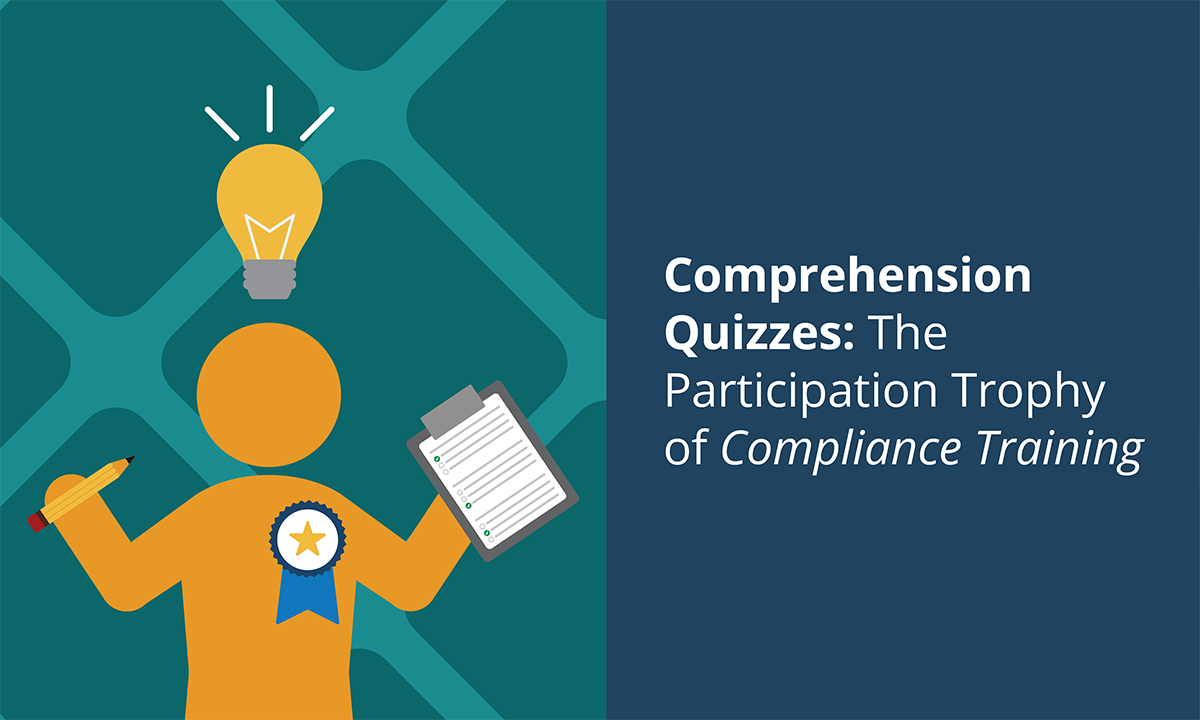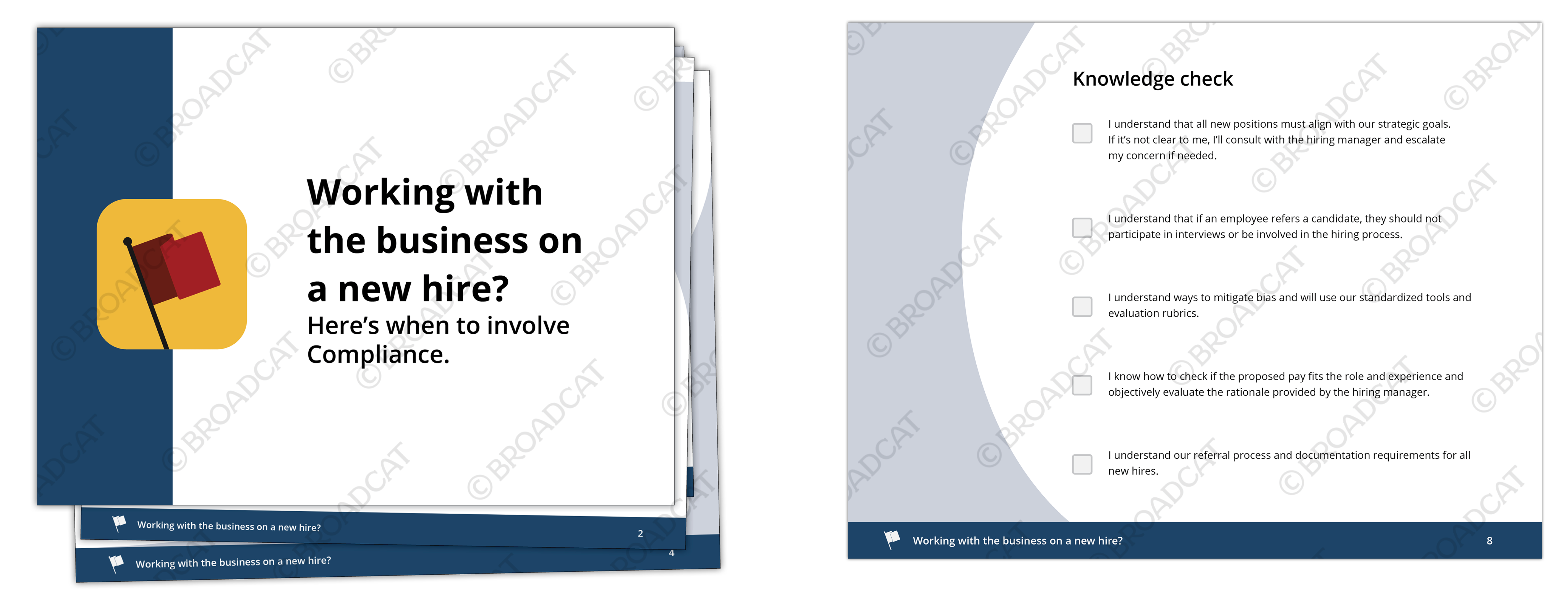
Comprehension Quizzes: The Participation Trophy of Compliance Training

Let's be honest about comprehension quizzes: they're like the participation trophies of the learning world. You view the required content—or click through it as fast as humanly possible—and then guess your way through the quiz’s multiple-choice questions. Once that’s done, boom! You’re "comprehended."
Calling them comprehension quizzes may make your leadership feel better, but it doesn’t achieve what the goal of your training really is: long-term retention and application. That’s why you don’t see quizzes recommended anywhere in the Federal Sentencing Guidelines. Instead, the DOJ focuses on monitoring activities to gauge effectiveness (aka compliant behavior; what you should be testing for).
You could put lipstick on a pig, but it’s still a pig. | Source: Sing by Illumination Entertainment via giphy
In most cases, you don’t need quizzes and, in fact, they might even be detrimental to your program because of the messages they send:
❌ Compliance = Memorization.
Imagine you've crammed a bunch of new vocabulary words for 15 minutes. Presented with a set of definitions, you could probably pick the right word from a list based on what you just learned or by simply guessing. But, how likely is it that you’ll remember and use those words later today … or next week … or some later date in the future when our robot overlords have taken over? 🤖 Slim.
Define “omnipotent.” | Source: Mystery Science Theater 3000 via giphy
Measuring your employee’s short-term memory isn’t valuable, and their responses don’t equate to actually doing the things you’re telling them they need to do. Compliance isn’t taking training, it’s applying training, so you’re better off measuring the results of the application.
❌ Stuff covered in the quizzes is all they really need to know.
This is why so many people click through content to get to the quiz. They assume it’s the executive summary and all the other stuff is fluff they can skip without missing any key points. Instead, ditch the quiz and save them time by boiling your content down to only what your audience needs to know to be compliant. Then, give your teams on-the-job resources and follow-up with occasional reminders to reinforce how important following the guidance you've provided is. (We have a whole post on how to break down online training into microlearning campaigns, so go check that out if you need some inspiration.)
❌ It's not about understanding, it's about avoiding blame.
There’s no way around it. Comprehension quizzes (and their evil stepsisters, attestations) give off hella check-the-box vibes. They may be interpreted as the org not caring about understanding the material, and instead wanting to avoid blame if the employee ever makes a mistake. This misinterpretation becomes a double whammy if it reinforces fears of speaking up.
❌ Pass a quiz and you’re compliant.
Learning isn’t a one-time activity, so your training shouldn’t be either. By awarding certificates for earning a passing score, it makes compliance feel like something you earn by completing a task and then moving on.
If you’re going to award compliance certificates, give them to your all-stars who have a track record of following your policies and doing the right thing. Those are the behaviors that often get overlooked, because it’s so easy to get distracted by the folks who are doing just the opposite.
❌ The Compliance Team is oblivious to how the business works.
Quizzes often test knowledge in a vacuum, completely detached from how your teams will actually use it. It's like learning to swim on land—not so helpful when you hit the water. This can make the whole exercise feel pointless. Plus, the context of the training and how you frame the questions can influence the answers, further muddying the waters.
So what’s the alternative?
Fear not, there's light at the end of the quiz-filled tunnel! Swap ‘em out for these worthwhile alternatives.
- If your training lends itself well to simulations, drills, or other practical applications, do it! Hands-on training is hands-down the best.
- Look for real-life case studies that are tailored to the audience you’re training. They can analyze the situation as a team to discover on their own how to avoid disaster. Wrap up the case study with takeaways so you’re sure your folks will know what to do when faced with a similar situation.
- Have your leaders deliver a quick training and talk their teams through discussion questions. The beauty of this approach is that you don’t have to come up with relevant scenarios for every audience; your employees will do it for you. Plus, this is an excellent way to generate peer feedback, and to encourage different perspectives and active learning.
If you’re still getting pressure to quiz, replace your comprehension questions with:
- A test-out quiz where employees who’ve taken the course before can demonstrate their competency on the topic and get credit for the training. As long as there haven’t been any major changes in the concepts, you can repurpose your comprehension quiz into a pre-test. Read our blog post on testing out to learn more.
- Un-scored self-assessment questions that ask what they learned, what causes confusion or frustration on their team, and how they plan to implement the guidance. Not only will you get valuable feedback, but because they'll have already addressed these topics thoughtfully, your employees will also be more likely to follow through on it.
- Open-ended questions that encourage critical thinking and deeper understanding.
- Knowledge checks that are laser-focused on ensuring understanding and application without the elementary feel of quiz questions.
And guess what?! We just quietly added knowledge checks to all of our mini-modules available in Compliance Design Club to take the guesswork—and effort—out of carefully crafting application statements. Because they’re paired with contact information in the modules for those “wait, what?” moments, they show that you’re genuinely invested in your employee’s comprehension versus playing the gotcha blame game. 💜

Remember, compliance training doesn’t need to feel like a chore on a to-do list. There are plenty of opportunities to engage your employees in more meaningful and helpful ways that simply work better. Mix it up and reiterate your training and communications to make ethics and compliance an ever-present part of how you do business.



